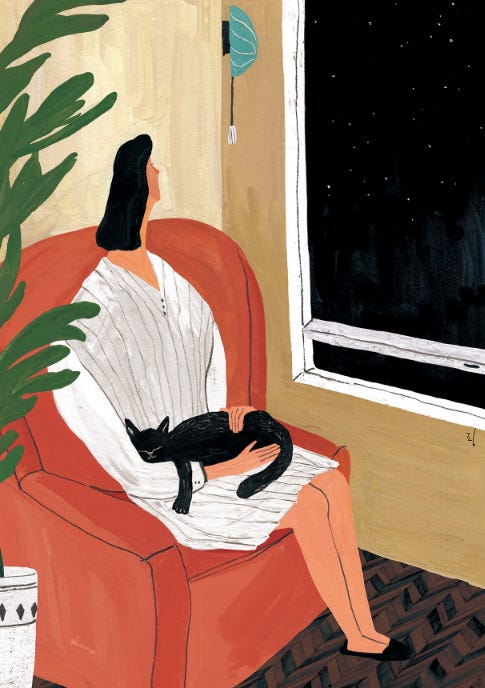By popular demand, here is your therapist-approved guide on how to sit with your feelings. Feel free to scroll all the way to the last section if you’re ready for the ‘how-to’ portion.
Why sit with your feelings?
We are sold the idea that feeling sad, angry, hurt is an inherently shameful thing. So we treat difficult feelings like unwelcome guests in our homes. Paradoxically, this leads to them overstaying their welcome.
When we suppress a feeling, anxiety may bubble to the surface. Anxiety is often, not a feeling, but a misguided attempt to outrun your feelings.
To sit with your feelings is to acknowledge they exist, to give them the space they deserve. And it is this acknowledgement that, strangely, will allow them to take their leave.

So, should everyone sit with their feelings?
If you’re in a space that is physically or emotionally unsafe - and so many of us are - some feelings might be too heavy for your body to bear. It is more important to honour that and seek pathways of healing that work for you, instead of some sanctimonious, Western idea of the ‘right way’ to do mental health.
A beautiful example of how healing can be adapted to your context is Dr. Sabah’s article Mental health in the Time of Genocide. She writes about the need to redefine recovery for Palestinian people by focusing on collective struggle, faith and resistance rather than through therapy.
What has been healing for you in your unique context and culture? I’d love to know in the comments.
What not to do when sitting with your feelings?
Sitting with your feelings does not mean allowing your thoughts to run amok. For most of us, when we have a big feeling , the way we speak to ourselves can become quite unkind.
This often sounds like -
“I made a mistake while sending out that email! How could I be so stupid ? I’m always so careless.”
“They haven’t replied to my text, they don’t even care about me. No one really does.”
Sitting with your feelings absolutely does not mean allowing this voice to take over and beat you up. It is more about noticing your feelings in a way that is gentle and curious, when you are present and connected with your body.

So, finally what is sitting with your feelings really?
Journaling, art and movement are all pathways to allow for your feelings, yes, but they may not always be accessible. If you’re like me, writing can sometimes be a way to overthink, analyse and move away from feeling instead of closer to it (And yet, as you can see, I do enjoy it very much).
This is why my favourite model for allowing a feeling is called the ‘RAIN’ model by Tara Brach. Here’s how it works -
Recognize - Name the feeling, noticing what comes up in the body as you do. Even just naming an emotion sends soothing neurochemicals to activated parts of your brain.
Allow - You need not evaluate, dismiss, avoid or condemn the feeling. It is as natural for you to feel as it is for there to be a blade of grass in the earth or a star in the sky. So grant it the permission to exist.
Investigate - Be curious about this feeling, almost as if you’re getting to know it better. Where is it coming from? Does it have a history to it? What does it feel like in the body to be spending time with it?
Nurture - This is the hard part! Speak to yourself gently, as you would a child or a beloved pet. I recently read that we punish ourselves for feeling lonely, but would never judge our pets for wanting the very same attention and care.
If these steps feel too much (and honestly, they’re really hard to put into practice), it is enough to just remind yourself that it’s alright to feel the way that you do.
Your feelings really are your guests. Yes, they show up uninvited. Yes, they’re annoying and determined to stay. And yes, they’re taking up so much of your time on a day that was supposed to be pleasant.
But they’re going to be around for a bit, even if you try to ignore them. They’ll take their leave once you stop fighting them. So you may as well welcome them into your home.





This would have been a game changer for me a few years ago! Sitting with your feelings, when you have no idea what that even means, is the most frustrating and confusing instruction in the world...but once you get it? Life changing. It's like a muscle, we've got to exercise it every day for it to come easily. This post has the power to help a lot of people. Thank you for sharing!
I love the R.A.I.N. technique! The way I was taught was different thothough. The N stood for non-identification or, put more simply, not me. The idea was to remember that emotions are passing through, and they do not define you. The nurture aspect of R.A.I.N was taught as more of a given, an approach to every step.